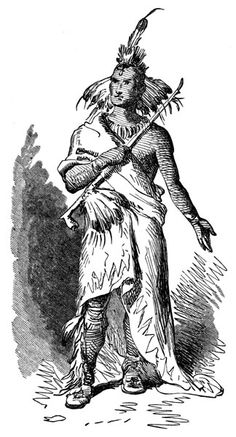Peter McQueen: Creek Chief
 Born probably 1780, and on Line Creek in Montgomery County, Alabama, was the son of James McQueen and a Tallassee woman. James McQueen was a Scotchman, born, it is said in 1683, deserted from a British vessel at San Augustine in 1710, went to the Creek Nation and died there in 1711, at the great age of one hundred and twenty-eight years.
Born probably 1780, and on Line Creek in Montgomery County, Alabama, was the son of James McQueen and a Tallassee woman. James McQueen was a Scotchman, born, it is said in 1683, deserted from a British vessel at San Augustine in 1710, went to the Creek Nation and died there in 1711, at the great age of one hundred and twenty-eight years.
There are no facts on record as to the early life of Peter McQueen. It was evidently only a few years before the Creek War that he married S v Durant. a daughter of Benjamin and Sophia (McGillivray) Durant, who was a daughter of Lachlan McGillivray. It is not improbable that his marriage into a wealthy ard influential family had much to do with his becoming the chief of the TalliEsees McQueen at this time was a wealthy man for an Indian, owning many negroes and much stock. He was a man of integrity, and lived on good terms with the American officials and other white people. Like many other half-bloods, through the influence brought to bear upon him from English and Spanish sources, he joined the hostile faction in 1813, and became one of the most prominent Red Stick leaders during the Creek war.
McQueen commanded the large band of Indians that went to Pensacola in July, 1813, for supplies of ammunition to be used in the contemplated war against the Americans. On their return march, while encamped. July 27, 1813, on Burnt Corn creek, they were attacked by an American force under’ Colonel Caller, and what is known as the battle of Burnt Corn took place, in which the Creeks were the victors. After the return of McQueen’s party, at some undetermined place, in accordance with the Indian method of keeping the exact day of an appointment, twenty short broken sticks, about six inches long, the sticks representing twenty days, were given to each warrior, one stick to be thrown away every day, and on the last day, when the last stick was thrown away, the warrior was to make his appearance at the rendezvous. In this case, the rendezvous was the Holy Ground. Here in council as- sembled, the Creek warriors at first resolved to march to Coweta, destroy town and people, as here was the home and rallying place of all the friendly Creeks. But the families of the killed and wounded at Burnt Corn forced the council to change Coweta to Fort Mims, as it contained many of their white and half- breed antagonists at Burnt Corn, and to some fort in the fork of the Tombigbee and Alabama. Fort Mims was accordingly unanimously seelcted, and after two days’ discussion, Fort Sinquefield was the fort selected in the fork.
McQueen was a prominent chief at the massacre of Fort Mims. He seems not to have been present at the battle of the Horse-Shoe. After this defeat, he and his two brothers-in-law, John and Sandy Durant, placed themselves for a short time with their people on the headwaters of Line Creek. Thence they went to Florida. Owing to the confusion of the times, McQueen left his negroes in the Creek Nation, which were unjustly appropriated by some half-bloods, that were American partisans. He afterwards made a vain effort to have them sent to him in Florida. With these grievances it could hardly be otherwise that McQueen was by no means averse to reviving the war. General Thomas Woodward writes of meeting him and Josiah Francis at Fort Hawkins near the close of 1817. The two chiefs were there trading and their meeting with their old acquaintance, Woodward, was entirely friendly. Very soon after this, the fugitive Creeks and Seminoles were at open war against the Americans, and Peter McQueen was recognized as the head leader.
The war of 1818 in Florida, known in history as the first Seminole war, was fought almost solely by the friendly Indians under General William Mcintosh against the Red Stick Creeks and Seminoles under Peter McQueen. There was very little fighting done by the Americans. The most notable fight was on April 12, 181″8, at Econfinnah, in which McQueen was defeated with the loss of thirty-seven men killed, and six men and ninety-seven women and children captured; add to these, a number of horses and about five hundred head of cattle. Mcintosh’s loss was three men killed and four wounded. At the close of the Florida war McQueen took refuge on a barren island, on the Atlantic side of Cape Florida, where he soon after died. After his death his widow returned to the Creek Nation and married Willy Mc- Queen, a nephew of Peter, and became the mother of two daughters, Sophis and Mus- cogee, and two or three sons. Her children by Peter were a son, James, and three daugh- ters, Milly (Malee), Nancy and Tallassee.
References. — Pickett’s History of Alabama (Owen’s Edition, 1900), 517, 521; Meek’s Romantic Passages in Southwestern His- tory (1854), pp. 544, 547; American State Papers, Indian Affairs, vol. i, pp. 847, 849, 851, 852, 857; American State Papers, Military Affairs, vol. i, pp. 682, 683, 700, 749; Wood- ward’s Reminiscences of the Creek, or Musco- gee Indians (1857), pp. 9, 21, 25, 42, 44, 48, 97, 110, 153; Parton’s Life of Jackson (1861), vol. ii, pp. 447, 449; Buell’s History of Jack- son (1894), vol. ii, pp. 127; Halbert and Ball’s Creek War (1895), pp. 125-149.